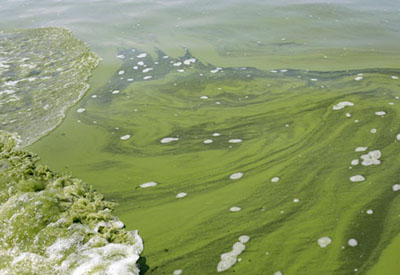Lake Erie braces for algae bloom

July 25, 2017
In this 2014 file photo, an algae bloom covers Lake Erie near the City of Toledo water intake crib.
Once again, a significant algae bloom is expected to form in western Lake Erie this summer, though it probably won’t be as large as some previous formations that posed health risks and hampered tourism.
Last month, the National Oceanic and Atmospheric Administration and research partners released their annual algae forecast for the shallowest and warmest of the Great Lakes, where massive algae formations are a recurring threat to the environment and the economy.
According to Ontario’s Great Lakes Strategy in recent years more algae has been growing in Great Lakes waters. Some shorelines are covered by slimy masses of nuisance algae, which degrades the quality of waterfronts. On Lake Erie, the fall of 2011 saw record levels of potentially toxic blue-green algae. Some bays in other parts of the Great Lakes, such as the Bay of Quinte, also experience problems with these blue-green algae blooms.
Boaters will notice the bloom if (when) it materializes. “It’ll be large, green and ugly and will cause the same kinds of issues it has in the past for charter boat captains trying to get people out to fish,” said Don Scavia, a University of Michigan scientist.
The 2016 bloom rated a mild 3.2 (of 10), which experts credited largely to dry weather. Spring and summer rainfall plays a key role in bloom formation by washing fertilizers from croplands into streams and rivers that flow into the lake. Phosphorus in chemical fertilizers and livestock manure promotes algae growth.
As we know the weather has been much wetter this year and the bloom size is expected to reflect that. The Great Lakes watershed is one of a kind. It holds nearly 20 per cent of the world’s surface freshwater and supports a population of over 30 million people.




























